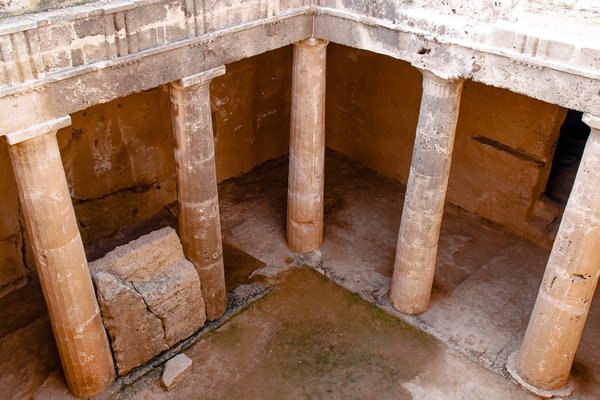Cyprus
Paphos
Paphos is an archaeological site of a place of worship from Antiquity, with fine mosaics.
It was known for its cult of the fertility goddess of Venus and has been in use since the Neolithic. The town blossomed as one of the oldest Mycenaean settlements. The mosaics of Nea Paphos, displaying scenes from Greek mythology, date from the later Hellenistic and Byzantine periods.
Community Perspective: located near a very touristy beach resort, the mosaics are generally considered the highlight of a visit to this sprawling site that covers a significant timespan in a way that isn’t always harmonious. Squiffy’s review (updated in 2023) gives a detailed overlook of all components and the practicalities involved. Tsunami has provided info on getting around by bus.
Site Info
Official Information
- Full Name
- Paphos (ID: 79)
- Country
- Cyprus
- Status
-
Inscribed 1980
Site history
History of Paphos
- 1980: Inscribed
- Inscribed
- 1979: Deferred
- Until more detailed info is available of possible adverse impact on sites of tourism development
- Type
- Cultural
- Criteria
- iii
- vi
Links
- UNESCO
- whc.unesco.org
- Official
-
- mcw.gov.cy — Nea Pafos
- mcw.gov.cy — Palaipafos
- Related
-
- visitpafos.org.cy — Visit Pafos
All Links
UNESCO.org
- whc.unesco.org — whc.unesco.org/
Official Website
- mcw.gov.cy — Nea Pafos
- mcw.gov.cy — Palaipafos
Related Resources
- visitpafos.org.cy — Visit Pafos
News Article
- April 6, 2019 cyprus-mail.com — Getty collaboration to improve management of Paphos mosaics
- Jan. 28, 2014 cyprus-mail.com — Paphos excavations uncover ancient bath house
Community Information
- Community Category
- Archaeological site: Ancient Greece
Travel Information
Recent Connections
-
Pre-Hellenic civilizations
Palaepaphos
-
Reduced from broader TWHS
Originally Aphrodite's Rock (Petra tou … -
Neolithic age
"Paphos, which has been inhabited since…
Connections of Paphos
- Geography
- Trivia
-
-
On Euro coins
Commemorative 2 euro coin Cyprus 2017 -
Preservation assisted by Getty Trust
Orpeos Mosaic (1988-9)
-
- History
-
-
Pre-Hellenic civilizations
Palaepaphos
-
Assyrian Empire
"It was part of a Cypriot political landscape that was under the suzerainty of the Assyrian Empire for a period, especially during the 7th century BC. The local kings, including the ruler of Paphos, were subordinate to the Assyrian king and had certain obligations, but they retained their own rule."See g.co
-
Ottoman Empire
The Lusignan manor house that now serves as the Palaipahos Museum, served as the centre of administration for the local Ottoman chiflik and aspects of the building date from this era. -
Located in a Former Capital
In Greco-Roman times Paphos was the capital of Cyprus -
Helladic Greece
Palai Paphos: Many of the archaeological remains are of great antiquity; the Temple of Aphrodite itself dates from the 12th century BC, and bears witness to one of the oldest Mycenaean settlements. (OUV) -
Sieges and Battles
Palaepaphos was besieged by the Persians during the Ionian Revolt and there is some debate about whether some of the archaeological remains are those of a siege mound or of an acropolis.See www.mcw.gov.cy
-
Hellenistic Greece
The mosaics of Nea Paphos are extremely rare and are considered amongst the finest specimens in the world; they cover the Hellenistic period to the Byzantine period. (OUV) -
Neolithic age
"Paphos, which has been inhabited since the Neolithic period" (OUV)
-
- Ecology
-
-
Seals
monk seal
-
- Architecture
-
-
Gothic
“The Gothic hall in the east wing [of the Lusignan manor house] is considered to be one of the finest surviving monuments of Frankish profane architecture on the island.”See www.mcw.gov.cy
-
Mosaic art
-
Cave Temples or Churches
Agia Solomoni
-
- Damaged
-
-
Destroyed or damaged by Earthquake
1159, 1222
-
- World Heritage Process
-
-
Reduced from broader TWHS
Originally Aphrodite's Rock (Petra tou Romiou) was included. -
First inscriptions
Cyprus 1980
-
- Religion and Belief
-
-
Mentioned in the Bible
Acts 13 6 - Visited by Paul who was lashed for preaching Christianity -
Christian Pilgrimage Sites
Agia Solomoni, with sacred tree -
Jewish religion and culture
Agia Solomoni catacomb church is believed to have been once the synagogue of the Roman Paphos. -
St Paul was here
St Paul's Pillar - "Saint Paul visited Pafos in 45 AD in an attempt to convert the ruler of the time to Christianity. He was successful in his efforts, but not before being tied and whipped to this otherwise unremarkable lump of stone. The Pillar of Saint Paul is one of several popular stops for pilgrims who come to see the religious sites of this early bastion of the Christian faith. He received 40 lashes for evangelising on the island." (visitpafos.org) -
Greek Orthodox churches outside Greece
The Palaipahos site at Kouklia incorporates the Church of Panagia Katholiki -
Goddesses
Aphrodite: Aphrodite's Sanctuary & Aphrodite's Sacred City are part of the WHS
-
- Human Activity
-
-
Ongoing Archaeological digs
University of Sydney (Paphos theatre site) reports up to 2010 and plans for 2011 -
Sugar
. Following the prohibition of religions other than Christianity the Palaepaphos site became a sugar cane plantation. The Lusignan manor house was centre of operations. (There is a Lusignan sugar-cane refinery in the coastal plain but although it seems to be part of the Palaipaphos archaeological site to the Department of Antiquities it appears not to be within the inscribed area.) -
Sea Ports
-
- Constructions
-
-
Asklepieion
Paphos Archaeological Park contains an Asklepieion in the west wing of the AgoraSee www.mcw.gov.cy
-
Lighthouses
This is a disused lighthouse which stands above a Roman amphitheater in Paphos. It is situated afew hundred meters from the sea. -
Pillars
St Paul's Pillar -
Prayer Labyrinth
Roman Mosaics in Villa of Theseus and Villa of Dionysos -
Protective Shelters
Mosaics -
Tunnels
5 tunnels in Palaipaphos -
Catacombs
Agia Solomoni -
Theatres and Opera Houses
Odeon Theatre -
Necropolises
Tombs of the Kings
-
- WHS on Other Lists
- Timeline
-
-
Built in the 2nd Millennium BC
The sanctuary of Aphrodite in Palaipaphos dates to the 12th century BC.
-
- Visiting conditions
-
-
Archaeological Site Reburial
The Mosaic of "Orpheus and the Beasts was discovered in 1984 and underwent a major preservation exercise before being put on public display under a shelter in 1989. In 2004 it was decided that the shelter was inadequate, it was dismantled and the mosaic reburied until such time as an improved sheter could be designed and constructed. The mosaic remains buried.
-
News
- cyprus-mail.com 04/06/2019
- Getty collaboration to improve man…
- cyprus-mail.com 01/28/2014
- Paphos excavations uncover ancient…
Recent Visitors
Visitors of Paphos
- 4lex
- Adrian Turtschi
- Afshin Iranpour
- ailsa
- Alexander Barabanov
- Alexander Lehmann
- Ali Zingstra
- Aljaz
- A. Mehmet Haksever
- Ana
- Ana Lozano
- AndreaTLV
- Argo
- Artur Anuszewski
- ashombob
- Ask Gudmundsen
- Aspasia
- Assif
- Axel Hansson
- Bamse
- basementonline
- BaziFettehenne
- Bill Maurmann
- Bin
- Boj
- Bram de Bruin
- Brendan Carroll
- Bruno_Pires
- butterflybird
- ButterflyEarring
- Carlos Sotelo
- CeeMon
- Cezar Grozavu
- cflw
- chenboada
- Cheryl
- ChrisN
- Christian Wagner
- christof
- Christoph
- Christravelblog
- Claire Bradshaw
- ClaraHH
- Clyde
- Corinne Vail
- Csaba Nováczky
- CugelVance
- CynthiaW
- Dagmara
- Dani Cyr
- Daniel Chazad
- Daniel Gabi
- David Berlanda
- David Marton
- del
- Dimitar Krastev
- Dirk-pieter
- Dolemite92
- Elf21
- Elia Vettorato
- Els Slots
- Emili Xaus
- Erfe91
- Eric Lurio
- Errol Neo
- Eva Kisgyorgy
- Evgenii
- Fan Yibo
- Farinelli
- Fede1203
- Feldhase
- Felicité
- Fernweh
- FK
- Fmaiolo@yahoo.com
- forest80
- Frederik Dawson
- FS
- Gary Arndt
- George Gdanski
- GerhardM
- Gilles
- Hadrianus
- Harry Mitsidis
- henrik_hannfors
- hotpickle
- Hurrvinek
- Iain Jackson
- Ivan Rucek
- Jana and Matt
- janameerman
- janem
- janis
- Janos
- Jan-Willem
- Jarek Pokrzywnicki
- Jawnbeary
- Jay T
- jcleek27
- Jesse S 2010
- Jezza
- John Smaranda
- Jonas Hagung
- Jonas Kremer
- jonathanfr
- Joyce van Soest
- Jurre
- Just_hatched
- Justin
- Kbecq
- Ken DJ
- KentishTownRocks
- Kerékgyártó
- Kevin McFarland
- Kevin Padley-Knight
- Krijn
- Kristin
- La Concy
- Laurey
- Leonie Geurts
- Liamps91
- Linz
- Lisu Marian
- Little Lauren Travels
- Loic Pedras
- Luboang
- Lucio
- Ludvan
- Luis Filipe Gaspar
- Lukasz Palczewski
- Lukemarshall
- Maciej Gil
- Maciej Gowin
- Małgosia Łupicka
- marcel staron
- Marcobrey
- Martina Rúčková
- Marton Kemeny
- Matthewsharris
- Max
- MaxHeAnouBen
- Michael Novins
- michaelsballard
- Michael Turtle
- Mikko
- Milan Jirasek
- Miloš Tašković
- Ming_9734
- Mo-han Je
- Monica66
- Mtlmr
- nan
- Niall Sclater
- Olli-Pekka Turunen
- Onkrad
- PabloNorte
- Patrik
- Patrik_globe
- peacemaker2142
- petar
- PeterH
- Peter Lööv
- Petteri
- Philipp Leu
- Philipp Peterer
- Pierre T
- Piotr Wasil
- Potsdamer
- Purrfect
- Qin Xie
- Rahelka
- Randi Thomsen
- Reiseblitz
- Reza
- Riccardo Quaranta
- RobRos
- Rob Wilson
- Roccobot
- Rodinia
- Roger Enarsson
- Roger Ourset
- Roman Bruehwiler
- Roman Raab
- Rudegirl
- Sandmann15
- Sandra!
- saraleonela
- Sclowitz
- Sehnsuchtsbummler
- serghei.belous
- Sergio Arjona
- Simonf
- Slavi
- Solivagant
- Squiffy
- Stanislaw Warwas
- StaziG
- Svein Elias
- Szabolcs Mosonyi
- Szabo Viktoria
- Szucs Tamas
- Tammy Gouldstone
- Taotao Chen
- Tarquinio_Superbo
- Thomas Buechler
- Thomas Harold Watson
- Timothy C Easton
- TimPick
- tommasorossotti
- tony0001
- Toxicologist
- triath
- Tsunami
- ValiaVeweth
- Veronica
- VLabhard
- VMThumper
- WalGra
- Walter
- Weecheng
- Wojciech Fedoruk
- Xiquinho Silva
- YaroMir
- Yevhen Ivanovych
- zfish
- Zizmondka
- Zoë Sheng
- Zsuzsanna Forray
- Александар Стојиљковић
Community Reviews
Show full reviews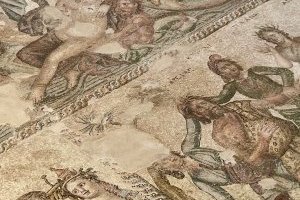
When I prepared my trip to Cyprus, I found that the 1980 ICOMOS document report on listing Paphos as World Heritage Site especially the matter of "Petra tou Romiou" was quite interesting and strange. In the old document three sites were proposed, two sites from Kouklia village which were Petra tou Romiou and Palaepaphos, and one site at Paphos, the Kato Paphos, but from official information right now those three sites turn out to be one site from Kouklia, the Palaepaphos, and two sites from Paphos, Kato Paphos with Neo Paphos and the Tombs of the Kings. I do not know why the area was clearly changed, maybe something happened behind the door of World Heritage Committee. Maybe the idea of Petra tou Romiou rock representing legend of Aphrodite’s birth was too intangible at that period before the idea of cultural landscape or mix site existed.
Although Petra tou Romiou is mysteriously omitted by UNESCO, the rock is still the most popular tourist destination of Paphos, and I am not surprised since the area is beautiful, I walked along the beach and hoped to see the wave and bubble in the form of Aphrodite as in the legend. The view around Petra tou Romiou is also great. I skipped the Palaepaphos site in Kouklia village and drove directly to the sites at Paphos. After lunch I leisurely walked to the famous Paphos Archaeological Park. I already noted that the attraction of Paphos is mosaic in the House of Aion …
Keep reading 0 comments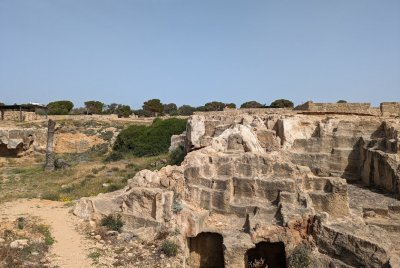
During our visit to Paphos, we focused on two key components, beginning with the tombs. Although these structures are referred to as “tombs for kings,” they actually served as burial sites for the upper class during the Ptolemaic era, when Cyprus was under Egyptian influence. While some of the tombs are quite spacious, their ornamentation remains relatively minimal. Personally, I had anticipated more intricate stonework beyond the simple pillars. Still, the views you get and the location on the coast are nice.
From the tombs, we strolled along the coast to the main archaeological area. Here, the true highlight lies in the mosaics, which cover extensive portions of the site. These mosaics are great, with some displaying a surprisingly modern aesthetic. However, I must admit that they don’t quite surpass the remarkable mosaics found at Villa Romana del Casale, which to me stands in a league of its own. Interestingly, Els’ review of the mosaics here in Paphos is more enthusiastic than those at Villa Romana del Casale.
Getting There
Paphos boasts an airport, serviced for instance by Ryanair. If you arrive during reasonable hours and avoid delays, catching a bus to town is a viable option. However, be prepared: Cypriot taxi drivers resist using taximeters and will overcharge you, quoting 50€ for a 15-minute ride. As a backup, consider installing the Bolt app; even then, the taxi fare to Paphos city was 35€. We found a German couple to split the costs.
From Karavella Bus …
Keep reading 0 comments
After leaving Ukraine in mid-September 2020 and spending 3 months in the Schengen Area (1/2 months in Poland and 2 1/2 months in Greece), it was time for me to leave the EU/Schengen Area and move to an EU/non-Schengen country for 3 months. So I decided to move to Cyprus. For me visiting WHSs has become a matter of changing country of residence during the pandemic. On the day I arrived in Cyprus I traveled from Larnaca through Choirokoitia WHS to Paphos by bus.
I ended up settling in the District of Paphos, one of the 6 districts of Cyprus, for 3 months. As such, I had a plenty of time to explore the 3 locations of this WHS, which I visited on 4 separate days by bus.
The website to use for bus in Cyprus is: http://www.cyprusbybus.com/setups.aspx
I visited them in the following order: Aphrodite's Sacred City at Kato Paphos, The Tombs of the Kings at Kato Paphos, Aphrodite’s Sanctuary at Kouklia. However, I will report them in the following order, which is the order I would recommend for visits.
1. Aphrodite’s Sanctuary at Kouklia / Palaepaphos
Bus 631 goes directly from the Kato Paphos / Harbor Bus Station (by the Archaeological Park) to the Aphrodite’s Sanctuary at Kouklia 7 times a day all year around. (Bus 630 also goes from the Municipal Market Station in Paphos to the Aphrodite’s Sanctuary 3 times a day all year.)
But both buses also go on …
Keep reading 0 comments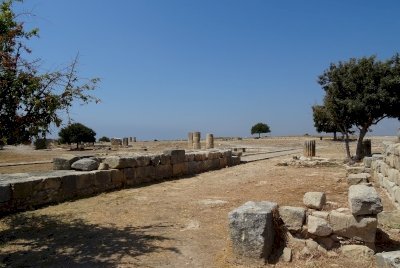
It was mid-day and the sun was intense. Not so much the heat, but the intensity of it, beating down like a physical weight. Entirely the wrong time to be walking around an exposed archaeological site. I sought respite in the shade of a tree. Around my head budding pomegranates dangled. They reminded me of the myth of the abducted Persephone, tricked into eating pomegranate seeds by her abductor, Hades, and condemned to spend half the year as his consort in the underworld. It was an apt thought. For gazing around the hard-baked earth of Palaepafos it was clear that the glories of the sanctuary of the goddess Aphrodite too had withered and vanished underground.
More than any other World Heritage Site Paphos has served as a sort of leitmotif to my adult life. I first visited in 1999 while revising for my university finals, sneaking in with my dad through a gap in the fence at the rear of the Nea Pafos archaeological site near the lighthouse (sorry!). In 2008, after discovering the fascinating world of Unesco World Heritage Sites, I re-visited, spending a day exploring not just the archaeological park but also the wider Kato Pafos area and the Tombs of the Kings. I returned to the archaeological park for a third time in 2011, this time with the woman who is now my wife. And now, in 2019, I was back again, accompanied not only by my wife but also my own son. Three generations over …
Keep reading 0 comments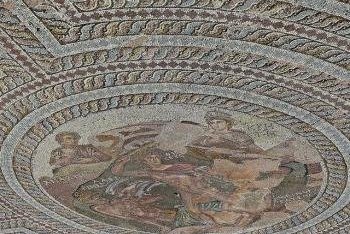
I visited this WHS in February 2016. Although the main site (2 archeaological sites) is close to the Paphos Castle, the other inscribed site, known as the tomb of the kings, is quite a distance away and close to one of the best hotels in Cyprus for afternoon tea. However, this was once a huge uninterrupted landscape and in fact the sheer size of the site together with the good condition of some mosaics and remains make it quite a worthy site in terms of OUV. There are better examples on the list, however it is a very interesting site to visit in Cyprus and the most visited tourist attraction on the island. The marble Unesco plaque is close to the amphitheatre/lighthouse and close to the entrance there was a very interesting exhibition on the avifauna depicted on the mosaic floors which I really enjoyed. Being mainly an outdoor site close to the sea, there are several live bird species you can spot and some of them you can also spot on the mosaic floors. The main mosaics can be visited on an indoor wooden platform at the House of Aion (my favourite being the Triclinium mosaic) and at the House of Dionysus (which houses the largest collection of complete mosaics; my favourite was the rather discoloured one forming the old thermal baths with a stone pluck in the middle). The House of Theseus still does not have an enclosure so its mosaic floors can still be enjoyed with direct …
Keep reading 0 comments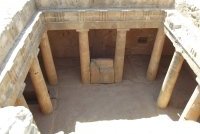
Another part of this WHS is the Sanctuary of Aphrodite near Kouklia village, just off the highway between Paphos and Limassol. This contains ruins of an ancient temple complex.
Keep reading 0 comments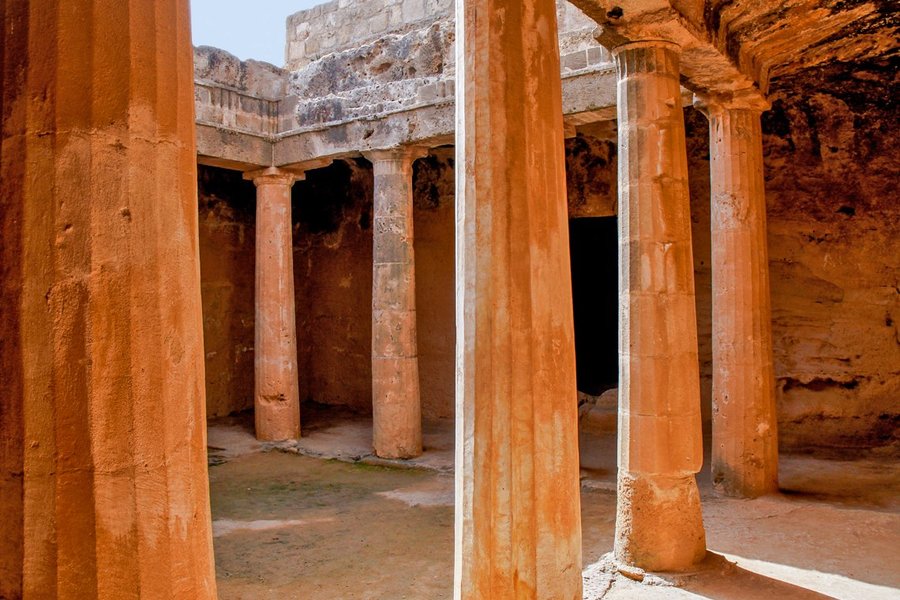
Paphos is a very touristy city on the Western coast of Greek Cyprus. It features abundant huge restaurants and English pubs which makes it lack any integrity it might have had. The findings for which Paphos got its nomination are of varying significane and quality. Of utmost beauty are its wonderfully preserved mosaics which are the most beautiful ones I've ever seen. They are of such artistic quality that they can be appreciated as art and not only for their historic importance. The other findings in the archaeological park and the nearby port and castle are much less interesting. Another well-known attraction is the Tombs of the Kings (not far to reach by foot). These catacombs are easily accessible and beautifully located along the shore. The old basilica is also worth a visit. What I found less appealing were the caves and Agia Solomoni catacomb which are surprisingly neglected and not that welcoming. The upper town (Ktima) is nice for a short stroll but nothing more.
Keep reading 0 comments
I recently had the experience of viewing the mosaics at Paphos in the snow! I had the benefit of seeing the true colours and found it incredible that they were laid 2,000 years ago. The whole scale of the site was amazing and well worth a future visit. Having the amphitheatre to myself, as everyone else had been put off by the weather, truely was an inspiring experience!
Keep reading 0 comments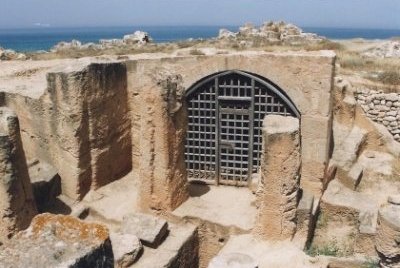
Modern Paphos is a beach resort as there are so many in the Mediterranean. It's an unlikely place to find treasures of the past, treasures that are carefully being unearthed. The most spectacular findings are the Tombs of the Kings, graves that are set up like houses. There's a strong Egyptian connection here, and also a comparison with Petra (Jordania) has been made.
Only a few hundred meters from there, the most beautiful mosaics I have ever seen have been discovered. We're not talking about a few colored stones here and there, but about the floors of whole rooms and even of one total house. An amazing sight.
Keep reading 0 comments
